This is a list of real life topics or fictional works which exist in reality that have been referenced in the Dragon Ball manga, the anime series Dragon Ball, Dragon Ball Z and Dragon Ball GT, and various video games spun off by the Dragon Ball series.
Dragon Ball[]
- The entire Pilaf Saga is a loose adaptation of Journey to the West, a famous novel from Ming-era China (published circa 1592).
- The seven Dragon Balls are based on the eight balls in Hakken-Den,[1] a famous Edo-era Japanese novel.
- Goku rescuing Turtle and returning him to the sea is a reference to Urashima Tarō's story (Bulma even makes an in-joke about it).
- In the chapter "...And into the Fire!", Puar curiously addresses the fact that Yamcha was not bothered by his encounter with Chi-Chi, to which he responds, "...That child!? Do you think I have a Lolita complex?" This is a reference to the 1955 novel Lolita, which is infamous for its controversial subject, wherein the protagonist becomes obsessed with a 12-year-old girl.
- In the chapter "Kame Kame Kame Kame Kame Chameleon" (this title is a reference to the Culture Club song "Karma Chameleon", although the original Japanese title is "Kame-Sen'nin no Kamehameha!!", which literally translates to "Kame-Sen'nin's Kamehameha"), Puar references Hawaiian king Kamehameha I, when confusing the Dragon Ball technique with "some old king of Hawaii." In fact, this is the likeness after which mangaka Akira Toriyama's wife suggested the technique be named after.
- At the conclusion of the episode "Boss Rabbit's Magic Touch" and chapter "Carrot Top", Monster Carrot and his subordinates are bound and taken to the Moon by Goku, where they continue to live making treats for children. This is an allusion to "The Rabbit in the Moon", a Japanese folk tale where rabbits live on the moon making mochi.
- Also, in the English "Carrot Top" chapter, two gangsters of the Rabbit Mob repeat the phrase "We're not worthy" twice to their leader, Monster Carrot, as an excuse for their defeat by Goku. This wording is likely a reference to the 1992 film Wayne's World (as although the chapter had been originally published in 1986, it was not until 2003 that it was localized by Viz Media).
- In the chapter "At Last... the Dragon!", Emperor Pilaf references Akira Toriyama's previous manga, Dr. Slump, in response to vulgar humor from his underling, Mai. Pilaf also breaks the fourth wall with his remarks that, "You know we do not appreciate vulgar humor here [...] Especially Dr. Slump references!! After all, some manga creators strive to make their work dignified and refined!! If you think that we'll pander to our audience's shameful love of pee-pee, kaka humor simply to boost the sales of this Dragon Ball comic [...] Then you are very sadly mistaken!!"
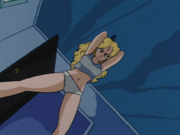
Launch's outfit, alluding to the closing scene of Alien.
- In episode 17, Launch's outfit is reminiscent of that worn by Ripley in the closing scene of the 1979 science-fiction horror film Alien.
- On the cover of the chapter "One Lucky Monkey", Goku is seen riding with Krillin and Master Roshi in a Porsche.
- In one scene during the Emperor Pilaf Saga, Emperor Pilaf is dancing about while holding a globe that has continents in the same shape as those of the real world. The scene itself could also allude to a similar scene in the 1940 Charlie Chaplin film The Great Dictator.
- The title of the chapter "The Big Sleep" may be a reference to the 1939 novel of the same name.
- In the episode "We Are the Five Warriors", during the match against Fangs the Vampire, Upa makes a stance that looks like a cross, and the vampire looks at him as a cross. Then across the screen as the vampire is going mad, it says "JESUS CHRIST" and "Oh God!" This references a common belief that vampires are vulnerable to crosses and crucifixes due to their unholy (and specifically un-Christian) nature.
- In the Red Ribbon Army saga during the fight with Ninja Murasaki, when Murasaki goes to hide, he has his camouflage turned the wrong way round and instead of looking like part of the tree trunk, it's the American Flag, and Goku even calls it a flag.
- After Krillin manages to kick General Blue in the face with enough force to make his nose bleed and Blue complains about his nose bleeding, he compares the action to throwing red paint on the Mona Lisa.
- In the Funimation dub of the episode of "Monster Beast Giran", when one of the Orin Temple bullies is picking on Giran, Giran says "I like you, so I think I'll kill you last." Arnold Schwarzenegger says the same thing in the movie Commando.
- In chapter 71 of the manga, when Krillin and Launch come back to the Kame House, the grocery bag says "Super Mario" on it, referring to the highly-popular video game franchise of the same name.
- When Yajirobe and Goku are deciding who will fight Cymbal, they play Rock-Paper-Scissors.
- Piccolo's egg found by an elderly couple in the episode "Lost and Found" is a parody of the Japanese fable Momotaro, the boy born from a peach. In the story, Momotaro is born from a large peach which floats down a river and is found by an elderly couple who have no children. Piccolo's egg is found in an identical manner.
- Bulma can be seen driving a Renault 5 Turbo at multiple points.
Dragon Ball Z[]
- In the TV special Dragon Ball Z: Bardock - The Father of Goku, when Goku's spacepod approaches Earth, it looks similar to the real world Earth, with North and South America clearly visible.
- In the episode "The New Threat", an ostrich farmer's pickup truck bears the Chevrolet logo (this has been only removed in the edited versions of Dragon Ball Z Kai).
- In the episode "Plight of the Children", there is a crate with the label "Georgia" on it and another crate with the label "Ranger", which can mean that the destroyed town is a reference to the small town in America "Ranger, Georgia".
- In the episode "The End of Snake Way", Goku recalls English physicist Isaac Newton with the statement, "Sir Isaac Newton would've never lived to tell about it if one of those hit him," referring to the severe gravity on King Kai's planet which caused a falling fruit to sink an indefinite depth into the ground. The statement in-context refers to an urban legend where Newton "discovered" gravity from being hit on the head by an apple that fell from a tree he was resting under.
- King Kai's pet monkey Bubbles may be named after the chimpanzee of the same name, formerly owned by the late American pop singer Michael Jackson.
- The closing narration of the episode "Goku's Ancestors" states that Saiyans Vegeta and Nappa have already entered the Earth's solar system and are passing the planet Jupiter (the planet is also depicted in the background of the scene).
- Shortly after Vegeta and Nappa reach Earth in the episode "A Black Day for Planet Earth", delirious East City residents in the vicinity of the landing site speculate and converse about what should be done. One suggestion to notify the police is countered with, "Yeah right. What'll they do? They'll just say it's a weather balloon." This is a reference to the Roswell UFO incident of 1947, after which the Eighth Air Force general officer of the time explained that a weather balloon had in fact been recovered by Roswell Army Air Field personnel, rather than a "flying saucer."
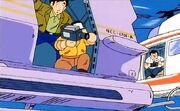
Screenshot from ep. 22
- At the 16 minute mark during DBZ episode 22, there is an easter egg reference to Star Trek (likely Star Trek V, as that film had come out earlier in 1989), as a Shuttlecraft from the Enterprise-A makes an appearance as a news "helicopter." This craft is later destroyed by Nappa.
- In the episode "Goku vs. Vegeta... A Saiyan Duel!", Oolong references the Empire State Building of New York City, when comparing Goku's power level as higher than the height of the structure.
- In the episode "Time's Up!", Piccolo mentions the battle between David and Goliath described in the Christian Old Testament, referring to the physical differences between himself and Nappa.
- In the episode "A New Goal... Namek", a news reporter on the television at Kong Hospital where Goku is left to recover after the battle with Vegeta closes his report with, "This is Milton Monroe reporting live, and now back to Barbie and Ken in the newsroom."
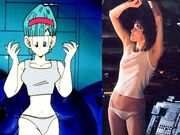
Bulma's outfit, referencing the ending of Alien.
- En route to the planet Namek in the episodes "Journey to Namek" and "Friends or Foes?", Bulma's appearance where she wears a bellyshirt and control briefs is similar to Ellen Ripley dressed in her underwear during the closing sequences of the 1979 film Alien, which also takes place in outer space.
- While searching the desert of Fake Namek in the episode "Hunt for a Dragon Ball", Bulma sings Peter Berring's main title theme for the Dragon Ball anime.
- Also in "Hunt for a Dragon Ball", Zaacro states that tornadoes on the planet never dissipate, and will always remain active like the Great Red Spot of Jupiter.
- When Cui lands on Namek in pursuit of Vegeta, he invites Vegeta to "come out and play." This is a reference to the famous chanting scene in the 1979 film The Warriors.
- In the episode "Secrets Revealed" when Gohan, Krillin, and Dende are hiding from Vegeta, Gohan says this isn't a good hiding place, and Krillin says "You got a better suggestion Einstein?" Einstein is again mentioned in "Memories of Gohan" when Chi-Chi wanted to call Gohan Einstein.
- Also in "Secrets Revealed", when Gohan and Krillin got brave and were about to give their position away to Vegeta, a big whale-like creature jumps out of the water, and Vegeta says "shucks, Moby Dick," referring to the 1851 novel Moby Dick.
- In the episode "The Eldest Namek", Orlen calls a Namekian survivor of Vegeta's rampage a "green goblin." This is also the name of an antagonist in the Marvel Comics series Spider-Man.
- In the episode "Clash of the Super Powers", when Goku decides to take seriously a barrage of boulders Frieza is telekinetically using to attack him, he declares, "Hammer time!" This may be a reference to the MC Hammer song "U Can't Touch This".
- In the episode "Frieza's Boast", Bulma references real life English primatologist Jane Goodall, with her statement that ". . . I could be the next Jane Goodall, except with frogs."
- In the episode "Namek's Explosion... Goku's End?", Yamcha recalls Jewish-Hungarian magician and escapologist Harry Houdini, with the statement, "Hey, Goku's gotten himself out of some hairy situations. If there's any way out he'll find it, he's like the great Houdini or something. I guarantee he'll get out of there."
- In the episode "The Heavens Tremble", a sharply dressed Krillin remarks to Gohan, "Yeah it's me, eh. See?" in a manner reminiscent of stereotypical 1930s B-movie gangster films, to which Gohan responds, "That's the worst Humphrey Bogart imitation I've ever heard." This is a reference to the American actor Humphrey Bogart, who early in his film career was often typecast as a gangster in such films.
- In the episode "Battle in Kami's Lookout", a Litt soldier tries to shoot Vegeta, and before retaliating, Vegeta remarks, "You just made my day." This is a possible reference to Clint Eastwood's character, Dirty Harry, who in the film Sudden Impact says to a criminal, "Go ahead, make my day," while holding him at gunpoint, in order to goad the criminal into attempting to shoot him and justify Harry's reason to shoot him dead instead of arresting him.
- One of the three possessed city residents who are seen ravaging a car in the episode "Suicidal Course" has a face similar in likeness to a hockey mask. Because there is some horror to the context of this character's appearance, his hockey mask face may be a reference to Jason Voorhees of the Friday the 13th franchise.
- During a dream sequence in "Frieza's Counterattack", Goku states that he guesses he "shouldn't have taken that left turn at Mars," paralleling the line "I knew I should have taken that left turn at Albuquerque," which is recited by Warner Bros' cartoon character Bugs Bunny in many of his theatrical shorts.
- In the Funimation dub of the episode "The Mysterious Youth", a flashback to Frieza's restoration process references a popular line in the American television series The Six Million Dollar Man, with a scientist's statement that, ". . . I am confident that we can rebuild him. We have the technology to make him faster, stronger and in every way more powerful than he was before."
- The premise of the Androids Saga is based on the 1984 science-fiction film The Terminator, where a robotic assassin and a human soldier, both from a post-apocalyptic future, are sent back in time to find a girl whose son will grow up to lead a rebellion against the rogue AI that rules the world in the future, the robot seeking to kill the girl and the soldier seeking to protect her.
- Android 16's voice in the FUNimation dub (provided by Jeremy Inman) gives the character a somewhat Austrian accent. This may be in reference to the Terminator film series, where the titular android is portrayed by Arnold Schwarzenegger, an Austrian-born actor well known for his distinctively thick accent. Another reference to Terminator made by Android 16, particularly to Terminator 2: Judgment Day, takes place during one of the alternate timelines of the Budokai Tenkaichi video game series, during the stage Affectionate Android. According to the timeline, Android 16 was sent from the future to kill Goku, but must first fight Android 8 to get to him (referencing the assassin T-1000, its intended victim John Connor and his defender, the T-800). Further referencing the film series, Android 16 even uses the word 'terminate' to express his need to kill Goku.
- In the episode "A New Guardian", the King of Earth, King Furry, states that "the only thing we have to fear is fear itself," a famous quote from former American president Franklin Delano Roosevelt's 1933 inaugural address.
- In the FUNimation dub of Dragon Ball Z: Super Android 13!, Krillin, Master Roshi, Future Trunks and Oolong are at a beauty pageant where they mention the countries of Russia, Spain, France, and Australia.
- Early in the original Japanese version of Dragon Ball Z: Broly - The Legendary Super Saiyan, Gohan calls Krillin the best singer in Japan.
- Also in Broly - The Legendary Super Saiyan, Paragus' death sequence has several striking similarities to Kaori's death in the 1988 animated film Akira, however to a much less graphic extent. In both films, the victim is crushed to death by someone close to them, and the actual sequences illustrating the deaths of both Paragus and Kaori show the area around them collapsing, before completely enclosing them. Kaori's death culminates in depicting her physically "popping" however, with her blood filling the crevasses of her compressed surroundings, whereas Paragus' body simply disappears within the caved Saiyan Pod. One plot-related distinction between the two is that Paragus is murdered by Broly, whereas Kaori is sucked into Tetsuo's body when his uncontrollable psychic powers morph it into an increasingly gigantic mass of flesh, and as such Tetsuo is only left hoping the best for his girlfriend without actually being aware that she has already died.
- A sequence during the World Tournament Saga features Krillin reading a newspaper entitled USA News.
- In the film Dragon Ball Z: Fusion Reborn, the "Dictator" character is an allusion to the late, infamous, Austrian-born German chancellor Adolf Hitler.
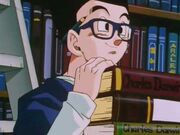
Gohan holding two books authored Darwin
- In the episode "The Innards of Buu", Old Kai says that Buu "Has trouble digesting those two" and then goes on to say "I have that same problem with Mexican food."
- In the episode "Mind Trap", Buu mentions "German pound cake."
- In the episode "Granddaughter Pan", Gohan can be seen holding two books authored by Charles Darwin. In the same episode, a boy can be seen wearing an LA hat, a reference to the real world city Los Angeles.
Dragon Ball GT[]
- The Shadow Dragons are a direct reference to Yamata no Orochi, a legendary 8-headed and 8-tailed Japanese dragon.
Video games[]
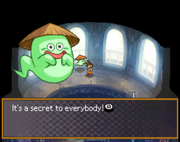
A ghost in Baba's palace
- In the game Dragon Ball Z: Attack of the Saiyans, a ghost in Fortuneteller Baba's Palace says "It's a secret to everybody" and gives the player 5000 zeni, which is a direct reference to the Secret Moblin in the 1986 Nintendo Entertainment System game The Legend of Zelda; the quote itself is often used throughout the Zelda series in a wide variety of contexts.
